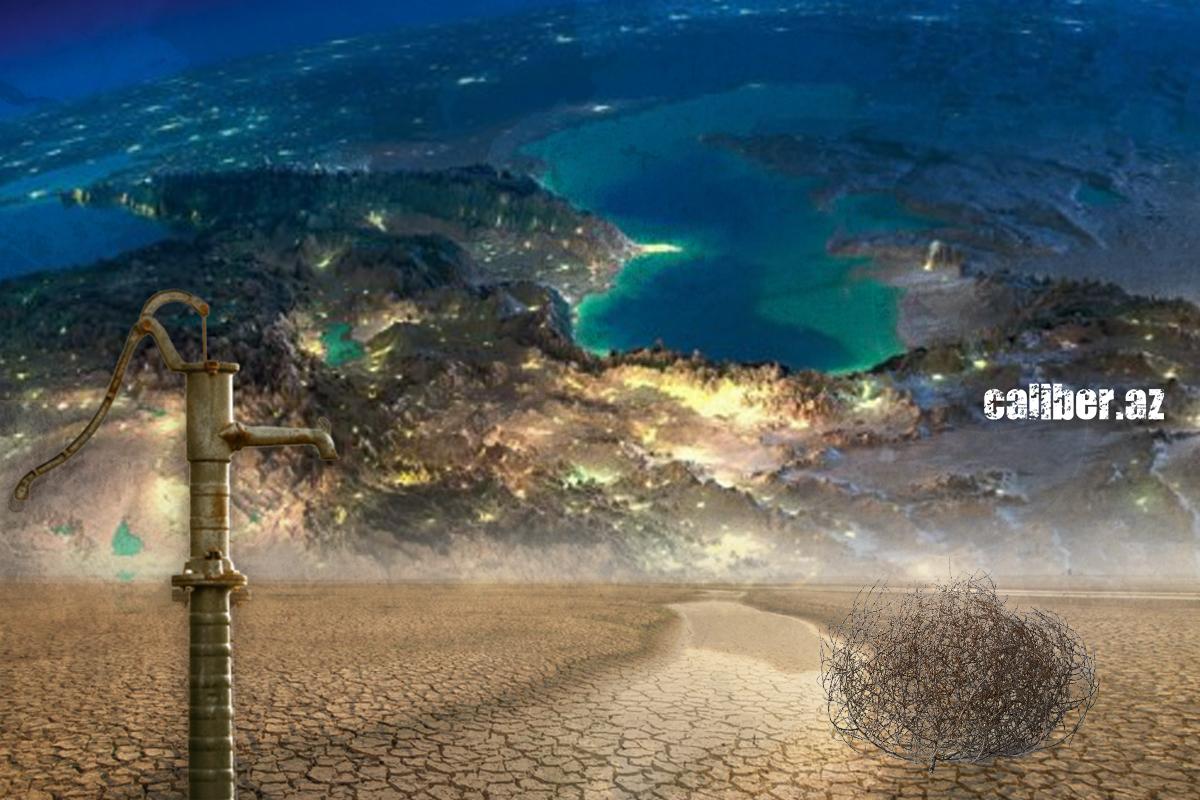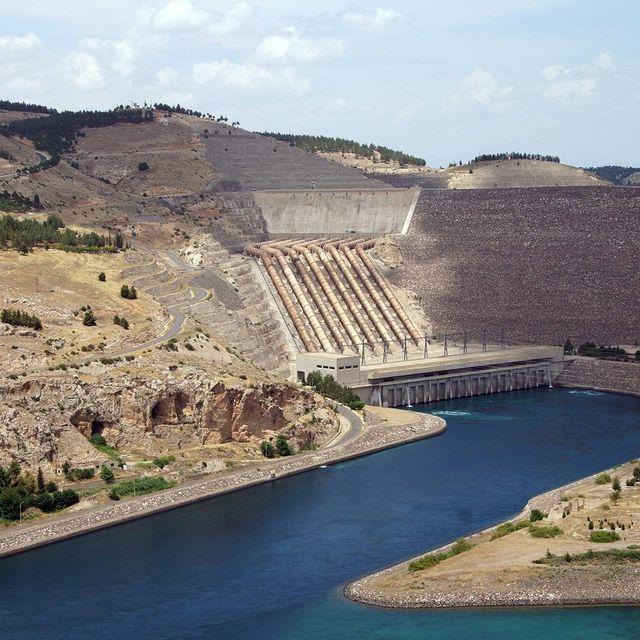UN warns of drought: How Azerbaijan is fighting desertification? Analysis by Caliber.Az
The war in Ukraine, which has turned into an acute civilizational rift, and the energy and food crises are far from the only disasters that this year promises to humanity. A recently published UN report warns of severe drought in a number of African countries and water shortages in other regions of the world. The problem of global desertification is very urgent for Azerbaijan as well, where the shallowing of the Kura and Araz basins in 2019-2021 caused serious problems in irrigation and water supply in some areas of the country. Heavy rains in April-May of this year slightly increased water levels in the country's rivers, but the sustainable overcoming of water shortage can be achieved only after the construction of new reservoirs, modernization of canals and application of economical irrigation systems.
Research conducted in recent years by UN agencies and international environmental, agricultural and conservation organizations shows that desertification processes have intensified and covered many regions of the planet. The most acute problem is in arid Africa and the Middle East, as well as a number of countries in West Asia: mass drying of water reservoirs and burning of pastures, have been registered in these regions since this year's spring. A joint report recently published by specialized UN agencies - the World Food Programme (WFP) and the Food and Agriculture Organization (FAO) - identified the riskiest "hot spots" - Ethiopia, Nigeria, Somalia, Kenya, South Sudan, partly Yemen and Afghanistan, where this summer's drought can lead to an unprecedented crop failure, loss of livestock and as a result - mass starvation and loss of life.
Incidentally, even relatively water-rich France has faced an unprecedented drought since May this year: a state of emergency was introduced in 24 departments of the country with the utmost economy of fresh water, and the government allocated 400 million euros to help livestock farmers. In recent years, the situation with access to irrigation water in the South Caucasus region, Iran and eastern regions of Türkiye is noticeably worse. Thus, the abnormally hot and dry summer of 2020-2021 caused a catastrophic shortage of irrigation water in Armenia, as a result, many regions of the country lost crops of vegetables, gourds, grains and fodder crops. Experts predict a further deterioration of Armenia's agricultural problems, given the disappointing climate forecasts, as well as the long-term collapse of the irrigation system: water losses in the country's irrigation canals exceed 60% and about half of all arable fields are not irrigated.

The residents of Iran's northwestern provinces have faced serious water shortages in recent years due to the processes of desertification that have intensified in recent years: snowless winters in the mountains, lack of spring rainfall, and depletion of underground sources result in the reduction of water flow in rivers and reservoirs by nearly half in the summer. Farmers and residents of the provinces of Ardabil, Zanjan, East and West Azerbaijan, Hamadan, and Qazvin feel these hardships particularly acutely; the water crisis has also led to the almost irrevocable drying up of Urmia Lake.
In recent years, the reduction of the water balance has also become felt in the eastern regions of Türkiye, where the Euphrates has noticeably shallowed and runoff in the estuaries of the Kura and Araz rivers has reduced. This is not just a climatic problem. The South-Eastern Anatolia Development Project (GAP), which aims to increase the irrigated area by 1.7 million hectares, has significantly increased water withdrawals for irrigation in Türkiye. For the same purpose, a number of reservoirs and dams regulating the flow of the main rivers of the South Caucasus were built in eastern Turkish vilayats. In Iran, excessive water withdrawal from the once full-flowing Araz has also been noted, and in Georgia, water from the Kura River is increasingly used for irrigation.
All these processes, both climatic and anthropogenic, have a very negative impact on the indicators of Azerbaijan's water balance: over the past 20 years, they have decreased by 15%, mainly due to rising air temperatures. According to the data from the Ministry of Ecology and Natural Resources, the country's water balance in 2021 was 24 billion cubic meters, of which about 15 billion accounts for surface water resources. For comparison, water reserves in 2016 reached 16.5 billion cubic meters/m.

At the same time, only 4 bcm of water resources are formed directly in Azerbaijan, while the remaining 11 bcm come to the country from abroad via transboundary rivers. This factor increases the vulnerability of the country to external factors, including indicators of water use in neighbouring countries and their intensity. The most noticeable damage to the country's agriculture was caused by the dry period in 2019-2021 when the shallowing of the Kura and Araz basins and a sharp decrease in reserves in reservoirs led to problems with irrigation in some areas of the country. The situation is somewhat better this year: heavy rains last spring increased water levels in most rivers of the country, and reservoirs managed to accumulate more water than last year.
However, this is not a reason to relax, as according to local experts and FAO experts, Azerbaijan is in the zone of risky agriculture: reduced precipitation in the Greater Caucasus Mountains and drying of rivers and springs in the foothills, drought and lack of water for irrigation in the lowlands, salinization and soil erosion - not a complete list of risks that local farmers face almost annually. Thus, over the past three decades, soil erosion and salinization in one way or another affected about 40% of the country's land fund. Over ten years ago, experts from the Organization for Economic Cooperation and Development (OECD) presented a detailed study of the consequences of desertification in Azerbaijan. According to the document prepared by OECD, if no modern irrigation and reclamation system is created in the country, then by 2030, due to the reduction of soil moisture, mainly because of the decline of subsurface water, the long-term damage to agriculture in Azerbaijan will exceed tens of billions of dollars.
In order to prevent such a negative trend, over the past decade and a half, billions of investments and many capital-intensive water projects were attracted to Azerbaijan. The Samur-Absheron Canal and the Takhtakyorpu Reservoir and associated irrigation canals in the north-eastern part of the country were constructed. Oghuz-Gabala-Baku water pipeline was built, the water system of Jeyranbatan reservoir was modernized, the Shamkirchay reservoir was constructed, and in general, an efficient water supply system in the western region was formed, etc. These projects ensured irrigation of many hundreds of thousands of hectares of agricultural land. The construction of the main Mil-Mugan collector, which diverts drainage water from more than 800 thousand hectares of land, should also be attributed to significant achievements in the field of reclamation. This allowed to increase productivity by one-third and prevent the re-salinization of 500 thousand hectares of land in Neftchala, Salyan, Sabirabad, Imishli and Saatli districts.

Nevertheless, the general climatic trend and excessive water consumption in neighbouring countries show the need for urgent measures to reserve additional water resources and to use them sparingly. The key vector in this direction was the orders of the Head of State "On measures to ensure efficient use of water resources" on April 15, 2020, and two state programs: "Program of Development of JSC "Land Reclamation and Water Management for 2020-2030" and "Program of Primary Measures for Water Loss Control and Efficient Use of Irrigation Water". The programs are designed for medium-term (up to 2025) and long-term (up to 2030) perspectives and envisage the construction of small reservoirs on mountain rivers, expansion of alternative water sources, including for settlements located in the Kura-Araz lowlands, application of water-saving irrigation technologies, development of a new mechanism for preferential use of irrigation water, etc.
According to experts' estimates, more than two-thirds of all water resources used in the country are used for agricultural needs, and the greatest problems are observed here. In particular, it is necessary to prevent enormous (over one-third) water losses in the distribution irrigation canals, most of which are earthen and need to be concreted, or introduce modern technologies (for example, Israeli, Turkish) using waterproof polymer coatings. It is equally important to ensure the gradual replacement of water supply to fields through ditches by introducing advanced water-saving technologies everywhere, ensuring the widespread introduction of cost-effective irrigation systems. A number of large farms and agro-parks in the country are already actively using drip, aerosol, fine-dispersed sprinkling, as well as beer systems for irrigation of grain fields and cotton plantations.
Rehabilitation works are carried out in various regions of Azerbaijan. In particular, in connection with the preparation for the spring-summer irrigation season, specialists of the Land Reclamation Department have recently launched repair and purification work on the 172.4 km long water channel "Yukhary Karabakh", which will reduce water losses. "The total length of irrigation canals in Azerbaijan is 52 thousand kilometres, and 72-73% of them are laid in earthen beds. Unfortunately, the loss of water in such canals is 35-40%," Zakir Guliyev, deputy chairman of Amelioration and Water Economy OJSC, said recently and underlined that design and estimate documents are developed to provide concrete lining for the 20 largest canals in the country. In their turn, the specialists of the JSC are carrying out works on designing ten water reservoirs, which are supposed to be constructed in the Greater Caucasus region, including on the Khakari and Bargushad rivers.

After the liberation of the Karabakh region from occupation, Azerbaijan is able to control almost all the water resources of the Lesser Caucasus. In particular, today the watercourse of the Araz border river is under full control, and thanks to the joint use with Iran of the Khudaferin reservoir with a capacity of over 1.6 billion cubic meters, irrigation of 260 thousand hectares of arable land in the south-west of the country will become available. As a result of the release of the Sugovushan reservoir with a capacity of 5.9 million cubic meters, today the uniformity of flows in Tartarchay is regulated and the irrigation problems in Tartar, Goranboy, Barda and Yevlakh districts are solved.
The mountain sources of 10 key rivers of the Karabakh region, including such full-flowing rivers as Khakari, Tartarchay, Bazarchay, and Khachinchay, are located in Kalbajar and Lachin districts. These rivers form the main water flow in the Lesser Caucasus region, including feeding the Sarsang reservoir with 560 million cubic meters of water.
The use of water resources of the Karabakh region today is the mainstream solution to water problems of the republic: here the repair works of Kondalanchay-1, Kondalanchay-2 and Ashaghi Kondalanchay reservoirs, included in the common system, are carried out and use of these water resources will allow irrigating 6.2 thousand ha of crops in Fuzuli district. Totally it is planned to restore or build from scratch 9 water reservoirs in liberated territories, including Aghdamkend, Khachinchay, and new Khakarichay and Bargushad reservoirs. Plans are also considered to reconstruct the Sol Sahil canal of the Tartarchay River, and rehabilitation work is also envisaged in the water sector of Aghdam, Fuzuli, Jabrayil, Zangilan, and Gubadli districts, which will ensure a reliable water supply for the future breadbasket of Azerbaijan.








